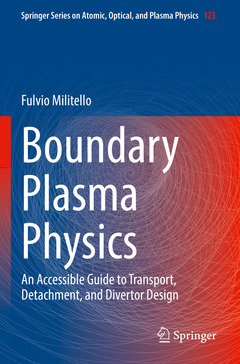Boundary Plasma Physics, 1st ed. 2022 An Accessible Guide to Transport, Detachment, and Divertor Design Springer Series on Atomic, Optical, and Plasma Physics Series, Vol. 123

1 Introduction
1.1 Essential Elements of Fusion Physics
1.2 The Plasma Exhaust Problem
1.3 Boundary physics at a glance
1.4 Goals and Synopsis .
2 Plasma Equations
2.1 Forces and Dynamics2.2 Kinetic Description
2.2.1 Liouville Equation and Probability Distributions
2.2.2 Boltzmann and Vlasov Equation
2.3 A basic discussion of plasma collision operators
2.3.1 From collisions to collision operators .
2.3.2 Boltzmann’s H-theorem, or a short history of irreversibility
2.3.3 Simplifying things: the BGK Operator
2.4 Fluid Description
2.4.1 Density Equation
2.4.2 Momentum Equation
2.4.3 Energy Equation
2.5 Implication of non-relativistic dynamics
2.6 Closures, Orderings and Reduced Models2.6.1 Braginskii equations
2.6.2 MHD
2.6.3 Drift-ordered equations
2.6.4 Geometry in reduced 2D systems
3 Sheath Physics
3.1 The Langmuir (or Debye) sheath
3.2 Debye Shielding
3.3 A quick review of wall models
3.4 Wall with perpendicular magnetic field or non magnetised plasma
3.4.1 Fluid sheath model and existence conditions
3.4.2 Particle fluxes and electrical phenomena in the sheath
3.4.3 Collisional presheath
3.4.4 Kinetic treatment of the sheath3.4.5 Bohm criterion for plasmas with multiple ions
3.4.6 Sheath energy transmission - formerly (and wrongly) known as heat transmission
3.5 Wall with inclined magnetic fields and magnetic pre-sheath
3.5.1 Bohm criterion for shallow angles and magnetic pre-sheath
3.5.2 Electric potential and dependence on the incidence angle
3.5.3 Effect of fluid drifts
3.5.4 Very shallow angles and role of collisions
4 Atomic, Molecular and Plasma-Surface physics
4.1 A few useful concepts and reaction terminology
4.2 Basic model with atomic hydrogen
4.2.1 Electron-Neutrals interactions
4.2.2 Ion-Neutral Interactions
4.2.3 Other interactions between the electrons, ions, and atoms
4.3 Molecular interactions
4.4 Impurities
4.5 Plasma-Surface interactions
4.5.1 Reflection, Trapping and Desorption
4.5.2 Wall Recycling
4.5.3 Sputtering4.5.4 Electron emission
5 Basic Exhaust Concepts
5.1 Magnetic Geometry and its connection with the boundary plasma
5.2 Protecting the Plasma Facing Structures
5.3 Elementary estimates of Scrape-Off Layer Width
5.4 Simple Geometrical Effects - Flux Expansion and Tile Tilting
5.4.1 Poloidal and Toroidal flux expansion
5.4.2 Target tilting
5.4.3 Total flux expansion and magnetic projection of the areas
5.4.4 Further observations on the geometrical effects5.5 Divertor Regimes: the Two Point Model
5.5.1 Derivation of the two point model
5.5.2 General solutions of the two point model
5.5.3 Collisionality and its role in the two point model
5.5.4 Applications of the two point model: divertor regimes
5.5.5 Extended two point model
5.6 Flux formulation and parallel profiles in the boundary plasma
5.6.1 Neutrals and particle sources
5.6.2 Particle flux
5.6.3 Energy flux and temperature profile
5.6.4 Target conditions
5.6.5 Upstream conditions
5.6.6 Mach number, velocity and density profiles
5.6.7 Electric potential
5.7 Divertor asymmetry in low to intermediate collisionality
6 Radiation and Detachment
6.1 Plasma/neutral processes at large collisionality and low temperature
6.1.1 Model equations for high collisionality cold plasmas
6.1.2 A closer look at the energy transfer mechanisms in a cold
pure plasmas
6.2 Impurity radiation and associated models
6.3 Divertor asymmetry at high collisionality or radiation
6.4 Detachment
6.4.1 Particle flux balance
6.4.2 Routes to detachment - a qualitative discussion
6.4.3 Role of pressure losses and recombination
6.4.4 Partial detachment and detachment onset
6.4.5 Deep detachment: Detachment Window and Stability
6.5 MARFEs and stable X-point radiation
7 Filamentary Transport
7.1 Basic Filament Physics and Observations
7.1.1 Filament propagation
7.2 Filaments at the Outer Midplane
7.2.1 Filament generation
7.2.2 Filament interactions (or lack thereof)
7.2.3 Parallel dynamics of the upstream filaments
7.2.4 Filaments at the X-Point
7.2.5 Response of filaments to different SOL conditions
7.3 Filaments in the Divertor Region
7.4 The Nature of Boundary Turbulence7.4.1 Important Statistical Concepts and Tools
7.4.2 Randomness and structure in temporal fluctuations
7.4.3 Diffusion and spatial fluctuations
7.5 Statistical models of filamentary transport and upstream profiles
7.5.1 Profiles, background and fluctuations
7.5.2 Phenomenology of the upstream profiles
7.5.3 Statistical framework
7.6 Heat fluxes at the Divertor Target: Wagner-Eich function
8 Conventional and Alternative Divertors
8.1 Single null Divertor: the ITER Solution
8.2 Alternative Divertor Designs
8.2.1 Why they are needed
8.2.2 Beneficial features in divertor design
8.3 The X-divertor
8.4 The Super-X divertor
8.5 Double Null divertor
8.6 The Snowflake Divertor and X-point target divertor
8.7 Liquid metals as plasma facing components
8.8 What will the future bring?
References
A Appendix
A.1 Of vectors and tensors
A.2 Viscous forces in all their glory
Index
A concise yet comprehensive review that shortens the learning curve for newcomers to the field
Modular structure allows expert readers to easily access specific topics of interest
Brings the reader up to speed on issues vital to design of plasma fusion devices
Date de parution : 12-2023
Ouvrage de 522 p.
15.5x23.5 cm
Date de parution : 12-2022
Ouvrage de 522 p.
15.5x23.5 cm



